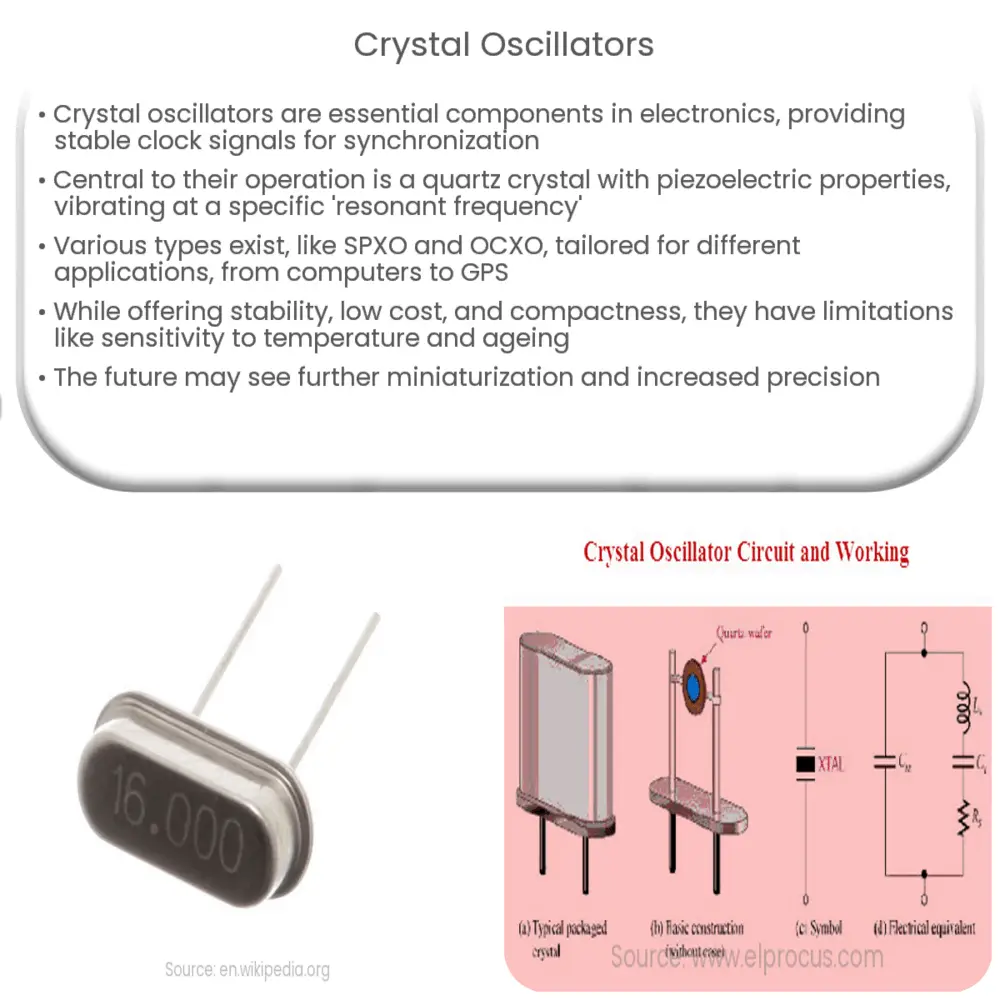Explore the world of crystal oscillators: their principle, types, applications, advantages, limitations, and future in modern electronics.

Introduction to Crystal Oscillators
A crystal oscillator is a vital component within many different types of electronic devices. It provides a clock signal, which functions as a rhythmic pulse that helps to synchronize the operations of an electronic system.
The Principle of Crystal Oscillators
At the heart of a crystal oscillator is a tiny slice of quartz crystal. This crystal possesses the physical property known as piezoelectricity. Piezoelectric materials generate an electrical charge when mechanical pressure is applied, and conversely, they mechanically deform when an electric field is applied to them. This characteristic is fundamental to the operation of a crystal oscillator.
Operation of Crystal Oscillators
- Oscillation: When an alternating electric field is applied to the quartz crystal, it vibrates at a specific frequency. This is its ‘resonant frequency’, determined by the physical dimensions of the crystal.
- Stability: The resonant frequency of a quartz crystal is extremely stable and reliable, making it ideal for use in a crystal oscillator. The stability is key to providing a constant clock signal for electronic devices.
Types of Crystal Oscillators
There are several different types of crystal oscillators, each suited to different applications.
- Simple Packaged Crystal Oscillator (SPXO): The simplest type of crystal oscillator, it consists of a quartz crystal and a basic oscillator circuit.
- Temperature-Compensated Crystal Oscillator (TCXO): This type incorporates a circuit that adjusts the oscillator’s frequency to counteract the effects of temperature changes on the crystal’s frequency.
- Voltage-Controlled Crystal Oscillator (VCXO): In a VCXO, the frequency of the oscillator can be adjusted slightly by varying the input voltage.
- Oven-Controlled Crystal Oscillator (OCXO): The most stable type of oscillator, the OCXO maintains the crystal at a constant temperature, typically by enclosing it in a temperature-controlled oven.
Applications of Crystal Oscillators
Crystal oscillators are ubiquitous in the world of electronics. They are used in a wide array of devices to provide accurate timing signals. Some of these applications are:
- Computers and smartphones: The processor in these devices requires a stable clock signal to synchronize its operations.
- Telecommunications equipment: Crystal oscillators provide the timing signals necessary for data transmission.
- Global Positioning Systems (GPS): Crystal oscillators provide the highly accurate timing signals needed for GPS to accurately determine a location.
Advantages of Crystal Oscillators
Crystal oscillators have several significant advantages that have led to their widespread use.
- High Stability: As mentioned before, the resonant frequency of a crystal oscillator is extremely stable, allowing it to provide a reliable timing signal.
- Low Cost: Despite their high performance, crystal oscillators are relatively cheap to produce, especially in large volumes.
- Small Size: Crystal oscillators can be made very small, which is particularly important in modern electronic devices where space is at a premium.
Limitations of Crystal Oscillators
Despite their many benefits, crystal oscillators are not without their limitations.
- Sensitivity to Environmental Conditions: The frequency of a crystal oscillator can be affected by temperature changes, although this can be mitigated with a temperature-compensated or oven-controlled crystal oscillator.
- Ageing: Over time, the characteristics of the quartz crystal can change slightly, causing the frequency of the oscillator to drift. This is known as ageing.
Future of Crystal Oscillators
The future of crystal oscillators is likely to involve further miniaturization and improved stability. With the advent of nanotechnology, we could see the development of even smaller and more precise oscillators. In addition, as wireless communication and computing technology continue to evolve, the demand for high-quality, reliable timing signals will only increase. Crystal oscillators will no doubt continue to play a crucial role in these developments.
Conclusion
In conclusion, crystal oscillators are an integral part of modern electronics, providing the reliable and stable timing signals required by countless devices. Despite certain limitations, their advantages of high stability, low cost, and compact size make them the preferred choice in many applications. As technology continues to advance, we can expect that crystal oscillators will adapt and evolve to meet the increasingly demanding requirements of the digital age.

